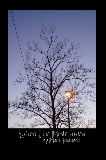The tornado came down directly upon the cemetery where Aura Hay was buried in 1886, and that means something to me. There was only one witness to its formation; his name was John, he was fourteen, and he had been living with his mother and two brothers in a dilapidated shack in the woods. As it happened there was a clear view across a nearby field to the cemetery hill, and after that black vortex touched down it plowed straight toward John’s family’s shack. He said he felt like a mouse in front of a stampeding elephant, and as trees began to rise out of the earth and fly about his family threw themselves flat to the floorboards. They were completely engulfed in the heart of the funnel (it sound liked a train was coming, John said) but it left their wretched shack intact, and moved on to cause greater damage to the rural subdivisions to the east. It was when John and his brothers wandered in that direction the next morning—to gawk at the horror—that a local news meteorologist stopped and interviewed them; and that man’s subsequent reporting on the evening news is how I found out about the whole thing.
Eel River, Indiana is not what you would call a bustling city. Once upon a time the military built enormous war machines in the factories here—those towering mechanized landwalkers known as Crollhorses, which won the Second World War for Amerika, if you believe the history books—but that era had long since past and now, today, Eel River was the absolute last target on any army’s map. There was nothing anyone wanted here, just people, and commercial development, and a struggling artists’ community in the heart of town. Even the river had ceased being important; where once there were annual, massive log jams from the lumberjack camps down south, now there were only the occasional sport fishermen or kayakers. One positive thing could be said for the Eel, however, and that was its purity. No river in Amerika was so clean, and you can bet there were some courageous government officials laying down the mandates to keep it that way. It had become a source of local pride after the factories shutdown, but it didn’t bring any real money into town.
The ghosts brought in more money than the river did, and they were, officially and on the books: “an unconfirmed phenomena, generally believed to be a localized hysteria of the indigenous populace, popularized by common lore of the region.”
Any given person on the street, however, might be able to recount seeing just such a phenomenon, and sometimes under greatly unsettling circumstances. When people talked about the ghost town of Gnaw Bone forty-one miles southwest of Eel River, they honestly meant the specters implied by that phrase, not simply the long-dead boomtown it was in truth. There were missing persons, strange murders, all manner of unsolved crimes around the county. There was even a cryptozoological mystery known informally as the Crumstown Slayer, to which several cattle mutilations, two dead dogs in a tree, and one bled-dry horse were attributed. No one had ever seen or photographed it, just the gruesome things that they believed was its handiwork. The complete lack of any tracks, spoor, or left-behind fur or feathers created rumors that something dark and intangible from Gnaw Bone had gotten bored waiting around for lost tourists to wander into its range, and had gone out a-hunting. I was fifteen and my folks still made me keep to a nine o’clock curfew if I was going to be anywhere west of Peach Road or south of Kern, even when nothing unexplained had happened for two summers running.
But then the tornado came, just like Aura (dead at twenty-two) told me it would, that day on Crumstown Highway, when the corn was six-foot high. And I set my own curfew a little earlier: indoors by dusk, and prayers said before midnight.
skip to main |
skip to sidebar
a panther in the snow
-
►
2010
(3)
- ► March 2010 (1)
- ► February 2010 (1)
- ► January 2010 (1)
-
►
2009
(30)
- ► November 2009 (1)
- ► October 2009 (1)
- ► September 2009 (2)
- ► August 2009 (3)
- ► April 2009 (7)
- ► March 2009 (1)
- ► January 2009 (10)
-
▼
2008
(58)
- ► December 2008 (4)
- ► November 2008 (1)
- ► October 2008 (4)
- ► September 2008 (6)
- ► April 2008 (4)
- ► March 2008 (7)
- ► February 2008 (3)
- ► January 2008 (5)
-
►
2007
(21)
- ► December 2007 (2)
- ► November 2007 (2)
- ► October 2007 (8)
- ► September 2007 (9)



No comments:
Post a Comment